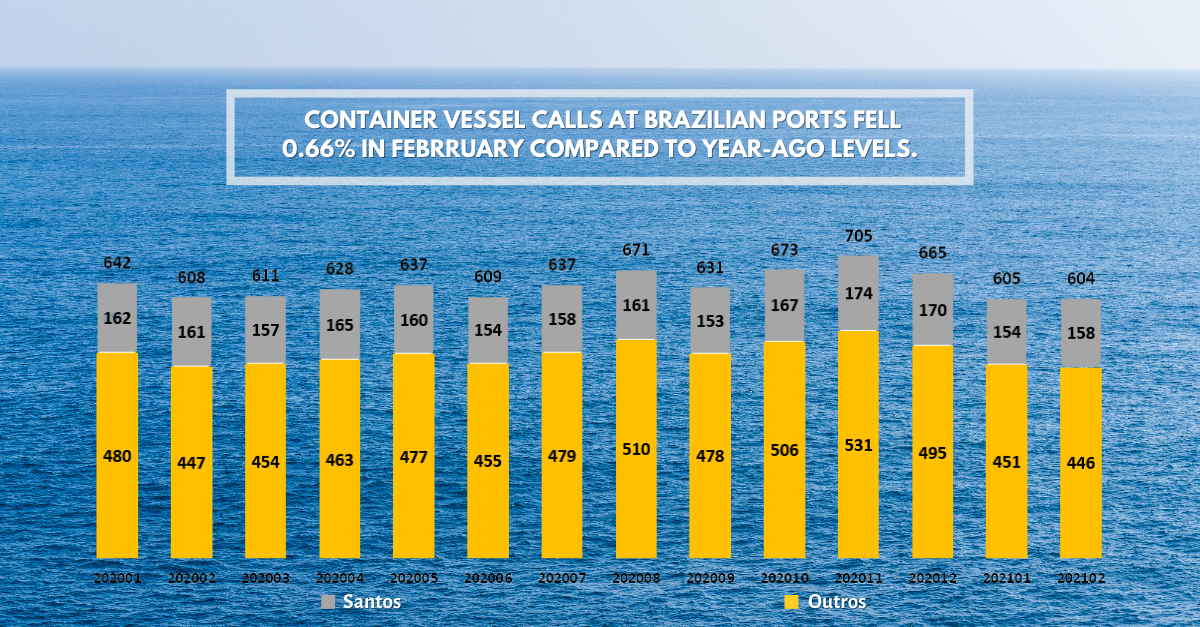
Fewer vessel calls but higher volumes handled at Santos this year YoY
Mar, 07, 2021 Posted by Ruth HollardWeek 202110
In February, container vessel calls in Brazilian ports fell by 0.66% compared to the same month in 2020. Compared to January, the drop was 0.16%, just one call less. The survey was carried out by the DatamarNews team based on Datamar data.
Despite the slight drop in February, when compared to the first two-month periods of 2020 and 2021, the drop was greater: 3.28%, since last January, 37 fewer container vessel calls were recorded in Brazilian ports compared to January 2020.
Container Vessel Calls in Brazilian Ports per Week | Jan 2020 to February 2021
Source: DataLiner
Comparison between ports
When comparing ports, we can see an uneven movement. While the Port of Navegantes showed an increase of 15.12% in the number of vessel calls, the Port of Rio de Janeiro had a drop of 17.02%. In Santos, the drop was 3.41%.
According to the Santos Port Authority, the drop in the number of berths does not mean less cargo handled. For example, 342 ships docked at the Port of Santos in January, between container carriers and others, 9.5% below January 2020. Despite this, the total volume of cargo was 9.18 million tons, a result that was 10, 5% higher than in 2020 (8.31 million) and 1.4% higher than the record for the month of January, registered in 2018 (9.05 million tons), characterizing the increase in the volume of cargo per vessel.
The same situation was also observed in January at the Port of Itajaí. Heder Cassiano Moritz, General Director of Logistics Operations at the Porto Superintendence, explains that even with a 5% drop in the handling of TEU, there was a 6% increase in tonnage.
“Despite the reduction in the number of stopovers and containers, we move more tonnage, that is, we move more full containers and more loaded ships. It is very important for us to highlight this growth in the load per stopover, which was 22% compared to last year”.
He points out that more heavily loaded ships are a trend that is increasingly consolidated among shipowners: “The reduction in the number of calls should be maintained, not only in public berths but in the complex in general”.
Container Vessel Calls in Brazil by Port | Jan 2020 and Feb 2021
Source: DataLiner (To request a DataLiner demo click here)
For March, according to a survey by Datamar, there is a blank sailing programmed at FEAS (Fareast) – SSA service (Sino South America), in week 13.
-
Economy
Apr, 19, 2022
0
The Brazilian trade balance was at a surplus of US$ 17.28bn until the 3rd week of April
-
Vessel Calls
May, 19, 2020
0
Vessel calls at Brazil’s ports increased 3.42% YoY in last four weeks
-
Oil and Gas
Jul, 12, 2022
0
Importers in Brazil wary of Russian diesel import claims
-
Meat
Jul, 10, 2021
0
Ciacarne expands slaughterhouse to export pork

